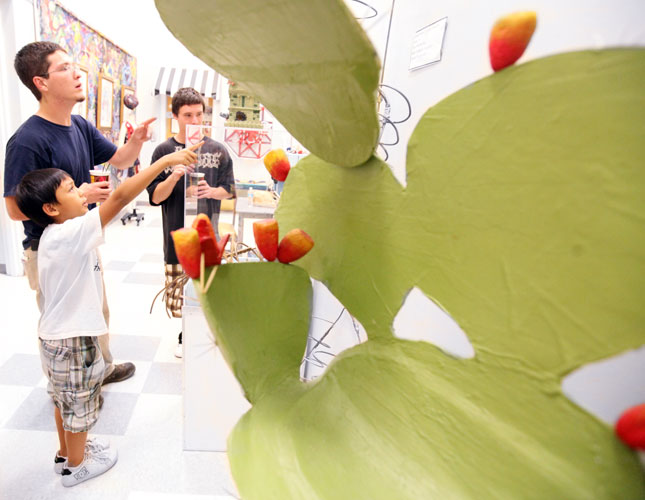INDIAN RIVER COUNTY — Deadline pressure may not be what most imagine would the bane of an artist’s existence. In real world of art professionals as well as college fine art courses, projects have to be turned in on time.
That is clearly the case at Indian River Charter High School’s Visual and Performing Arts program, where the training is tough, intended to produce students who will view art as a career not just a pastime.
“I have a former student now studying at Savannah College of Art and Design who wrote and said, ‘You over-prepared us, Mr. Kornicks,’ ” says Harvey Kornicks, who heads the school’s art department.
If that’s the case, at least five more charter students are well-prepared as they head off to study art in colleges.
Jonathan Nguyen is heading to Ringling College of Art and Design in Sarasota; Sarah Lemley is going to the Art Institute of Chicago, Linn Tunberg is going to the Swedish School of Textiles, and Abigail Lacroix is majoring in art at UNC-Asheville. Victoria Zuckert is planning on a double major in art and hospitality at Florida Gulf Coast University.
“It is not often that you find in a community as small as Vero Beach programs that offer students the necessary background to pursue professional careers in the arts,” says Cynthia Aversa, the school’s principal and herself a former music major. “The foundation of our program revolves around the belief that the arts are a viable and important option as a career.”
Aversa says Charter’s arts emphasis continues despite the trend in many educational institutions to eliminate the arts from their curriculum.
“The great thing about a school where the arts are emphasized is that kids aren’t embarrassed about participating,” says Aversa. “Sometimes you get labeled. Here it’s completely accepted.”
Kornicks’ specialty is jewelry, though he teaches drawing, painting and sculpture.
His high expectations come from his belief that art is as serious a subject as any other, and that the kids who excel in it deserve to have the same demanded of them in their subject as students of math or science.
“I remember a professor told me we have a tendency to teach to children’s weaknesses, not to their strengths,” he says. “If you look at really successful people, chances are what they’re doing in their field now is what they were strong at early on in life.”
Kornicks ended up owning a gallery in Massachusetts where he sold his own jewelry as well as other artists’.
There, he met his wife, Margot Jaffe, from an old Vero family. They returned to Vero in the early 1990s and Kornicks briefly owned the Red Lion Gallery on Beachland Boulevard.
He taught art at Beachland Elementary for 14 years, then at Fellsmere Elementary and the Wabasso School, before settling in at Charter seven years ago.
He now heads the art department.
Ramayana Baba came to Vero 35 years ago to live and study at Kashi Ashram in Sebastian. He had studied art at the University of Massachusetts and began graduate school in sculpture at UC-Berkeley under the prominent abstract expressionist sculptor Peter Voulkas.
After discovering his adopted son had special education needs, Baba returned to graduate school in special education at Florida Atlantic University.
With that expertise, he got a job at Charter. Two years ago, Aversa approached him about teaching ceramics instead.
“One thing I’ve noticed here is that when other kids see kids doing well, they aspire to that,” says Baba. “That’s how I look at my program. I’m not doing anything different than I did last year. But the quality of work from these kids gets better and better.”
Because ceramics is taught with no prior required coursework, advanced students are working alongside beginners who may be taking it as a required elective.
The same is true for photography, taught by Jon Pine. Frank Colon teaches commercial art.
Baba’s 127 students are required to pay a lab fee for materials.
“The school tries to help, but with their budget cuts, everybody’s under some constraints. The biggest contributors are the parents. They’re incredibly generous in that way.”
In addition, Baba raises money for supplies by selling his students’ ceramic pieces, chiefly at the school’s children’s art festival.
“I have a bad rep,” he says laughing. “They’re always asking where their piece is, and I say, ‘Oh, I lost it.’”
Kornicks prefers not to sell his students’ art to pay for supplies. Instead, he himself buys materials, mostly at thrift shops.
“I will never let a kid go without money for a project if they really want to do something,” he says. “Fortunately my antiquing lets me buy stuff cheap.”
Kornicks supplied the mannequins that now populate the front and rear terrace of VAPA.
Students have painted the figures, formerly used in a dance supply shop, in a range of styles.
Other assignments for his drawing and painting classes have involved masks, tools, Styrofoam and feathers.
He issues the challenge, a theme for their art. They have to come up with a project in an allotted time.
“I’m a firm believer that my job as a teacher is not to be their friend but to hold them to a high expectation of what they’re capable of doing,” he says.

